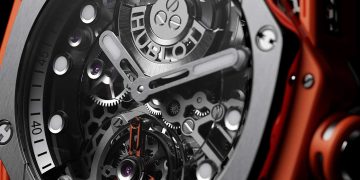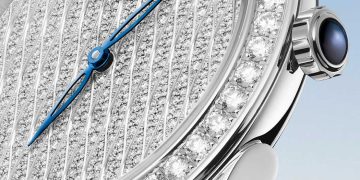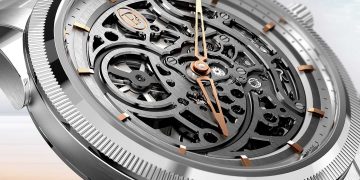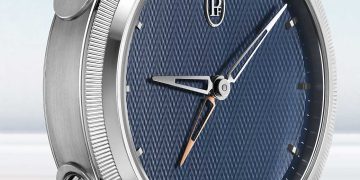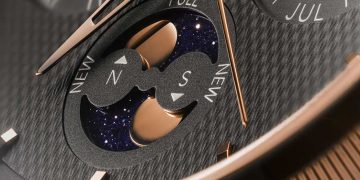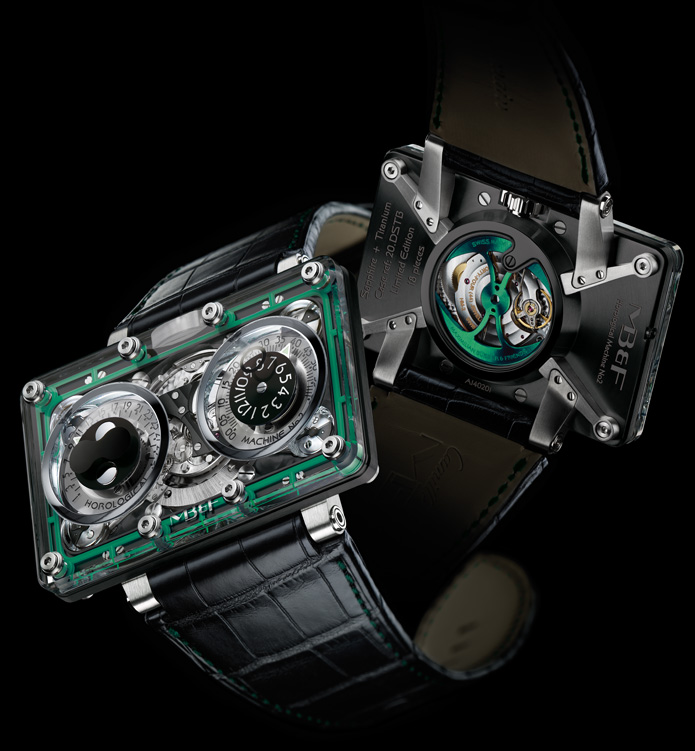
First launched in 2008, Horological Machine No2 revolutionized the world of haute horlogerie with its distinctive rectangular shape, flying buttresses, dual portholes and modular construction. The crystal-clear sapphire case of HM2-SV then took the revolution even further by offering unprecedented visual access into the meticulously hand-finished, 349-component engine powering the indications on HM2’s iconic twin dials.
But all good things come to an end and, after three very successful years, Horological Machine No2 takes one last bow on center stage with two final limited editions of 18 pieces each, both featuring sapphire cases: HM2-Black SV and HM2-Red SV close the HM2 collection, thus ensuring its exclusivity.
Synthetic sapphire watchcases are extremely rare for good reason. While sapphire retains its strength at high temperatures, has zero porosity and (below 300°C) does not react to acids, the very properties that make it so attractive also make it extremely difficult to mill, requiring sophisticated (and expensive) diamond tools to machine, followed by careful polishing to turn the opaque freshly cut or drilled surface transparent. The complex, three-dimensional form required for HM2-SV’s case, with its bevels, mounting holes, porthole cut-outs and embedded gasket track, pushed the limits of sapphire technology beyond what was thought possible. No less than 55 hours of milling, drilling and polishing are required just to create each sapphire case.
While both new final models are derived from the original HM2-SV, each has its own very distinctive identity.
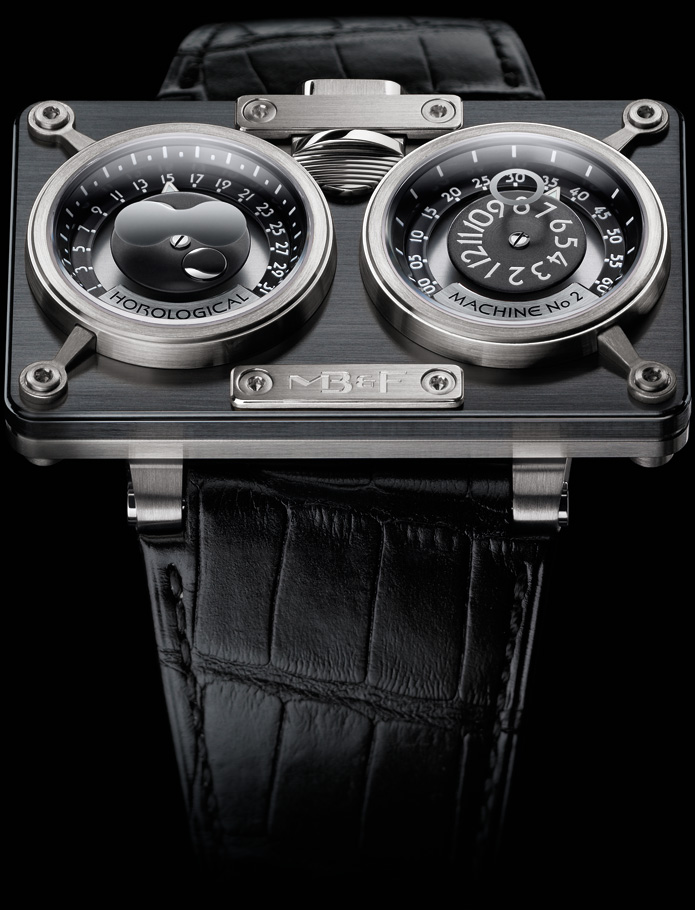
HM2-Black SV features a sapphire case, black dials and a black PVD titanium baseplate that makes a strongly contrasting backdrop for the unique architecture of the HM2 Engine inside, which is framed by an electric green rubber gasket clearly visible through the transparent top. Turning the watch over reveals yet another splash of colour from the vivid green 22K gold winding rotor.
HM2-Red SV has its sapphire case black dials mounted on a regal red gold baseplate. The black dials, black rubber gasket and the rich red of the caseback provide a stunning juxtaposition with HM2’s silver Engine. Turning the watch over rewards the viewer with
the sight of MB&F’s signature 22K red gold battle-axe rotor complimenting the red gold of the caseback.
The HM2 engine, developed by award-winning master watchmaker Jean-Marc Wiederrecht, features the world’s first mechanical movement offering: Instantaneous Jump Hour, Concentric Retrograde Minutes, Retrograde Date, Bi-Hemisphere Moon Phase and Automatic Winding. One highlight (of many) of the HM2 complication is the highly energy-efficient Jump Hour/Retrograde mechanism developed by Jean-Marc Wiederrecht, which uses his exclusive (and patented) asymmetrical-tooth gear wheels to ensure high precision and play-free functionality.
The sapphire case: Surprisingly, because it is largely unseen, the sapphire cases of these final editions are a substantial 3.6mm thick. Thanks to anti-reflective treatment on both sides – in itself no small technological feat to uniformly apply – the case becomes virtually invisible and allows for full appreciation of the myriad nuances of the complex movement. Eight mounting bolts traverse the sapphire plate like pillars, passing through the twin tracks of the rubber gasket sealing the sapphire case and caseback, add to the architectural nature of the three-dimensional case.
The case, with its flying buttresses, bolted portholes, was so complex – over 100 components go into its construction alone – that it could only be developed with an innovative modular method inspired by the Meccano sets of Maximilian Büsser’s childhood. And in line with best engineering principles, this modularity also simplifies future refurbishment of the case should it ever be necessary.
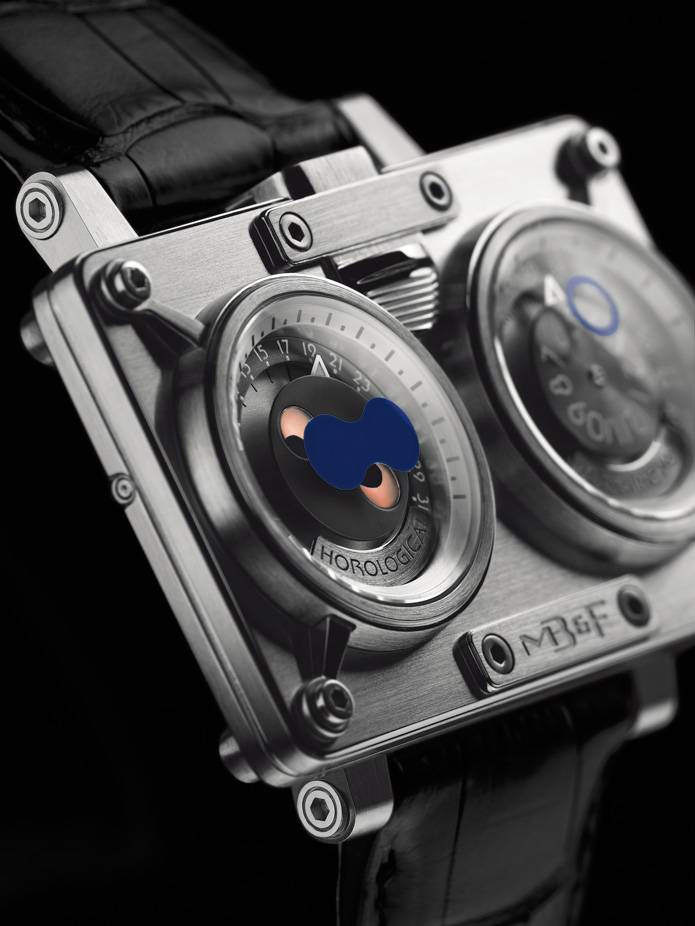
Technical Innovations: The principle technical challenge in developing the movement was ensuring that the jumping hour functioned both instantaneously and simultaneously when the retrograde minute flies back from 60 to 0. And not only instantaneously: without using excessive energy. The usual method of activating Jumping Hour indications is to store energy in the minutes before the change to power the jump; however, while this energy is being accumulated it takes power from the balance causing it to loose amplitude – an effect detrimental to time-keeping precision. Wiederrecht’s solution was as brilliant as it was simple: he designed a ingenious mechanism so that when the minutes fly back, a snail on the minute mechanism hits the hour star causing the hour to jump. The hour jumps instantaneously with the minutes because it is triggered by the minutes and, as the jump is powered by the energy of the minutes flying back, it has virtually no effect on the amplitude of the balance.
While the complications and functionality operate with maximum efficiency, with 349 components in the movement alone, there are no doubting HM2’s credentials as an incredibly technical tour de force.
The complication has another very special feature. Specific gears in HM2’s movement are manufactured to extremely high precision using Mimotec’s UV-LIGA technology. These gears mesh together with a virtually a no-tolerance/no-play engagement. Normally, gears interacting this tightly would bind; however, Wiederrecht’s patented asymmetrical-split-tooth gear design ensures this does not occur. The high precision of this gearing enables very accurate time-setting and offers high reliability.
To maximise the efficiency of MB&F’s already iconic battle-axe automatic rotor, one of the 22K gold blades was machined down to a razor sharp edge of just 0.2mm – a dimension that pushed the very limits of micro-machining!
While Horological Machine No2 is a high-tech machine of the 21st century, the quality and hand execution of the fine finishing is a showcase of the very best in traditional craftsmanship. Light flashing off hand finished mirror-polished surfaces and immaculate bevelling brings vivacity to the rich combination of colours, materials, shapes and textures.
HM2 Final Editions – Technical Specifications
HM2-Black SV and HM2-RedSV are limited editions of 18 pieces (each)
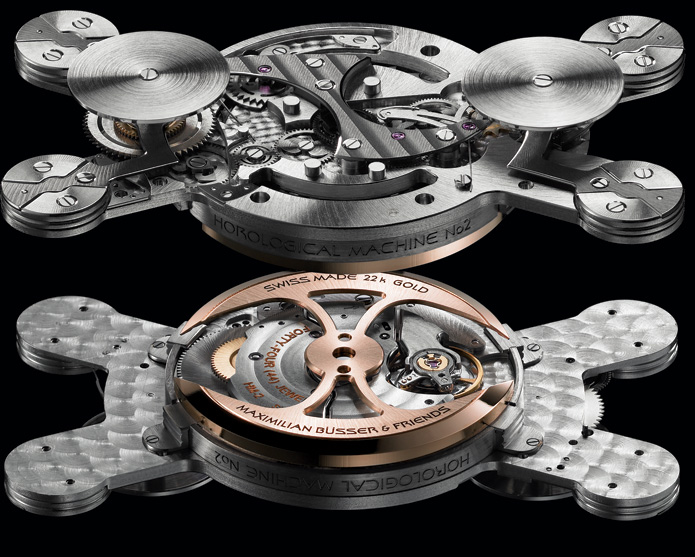
Movement:
Jean-Marc Wiederrecht/Agenhor designed functionality regulated and powered by a Sowind base
Balance oscillating at 28,800 bph
22K red gold battle-axe automatic winding rotor (green PVD coated 22K for HM2-Black SV)
Number of components: 349 including 44 jewels
Functions:
Left dial: Retrograde Date and Bi-Hemisphere Moon Phase
Right Dial: Jumping Hours and Concentric Retrograde Minutes
Case:
HM2-Black SV: Sapphire/black PVD coated titanium baseplate, electric green gasket, limited to 18 pieces
HM2-Red SV: Sapphire/18K red gold baseplate, black gasket, limited to 18 pieces
Dimensions (exclusive of crown and lugs): 59mm x 38mm x 13mm
Water resistant to 30 meters (3 ATM)
Number of parts: 120 (case only)
Sapphire crystals:
Sapphire case top and crystals over the dual dials treated with anti-reflective treatment on both faces. Display back with anti-reflective treatment on single face.
Dials:
Brushed sapphire and black metallic disks
Strap & Buckle:
Black hand-stitched alligator with 18K gold & titanium folding buckle
Presentation box:
Precision engineered aluminium and leather instrument case featuring an integrated Rüeger thermometer
‘Friends’ responsible for
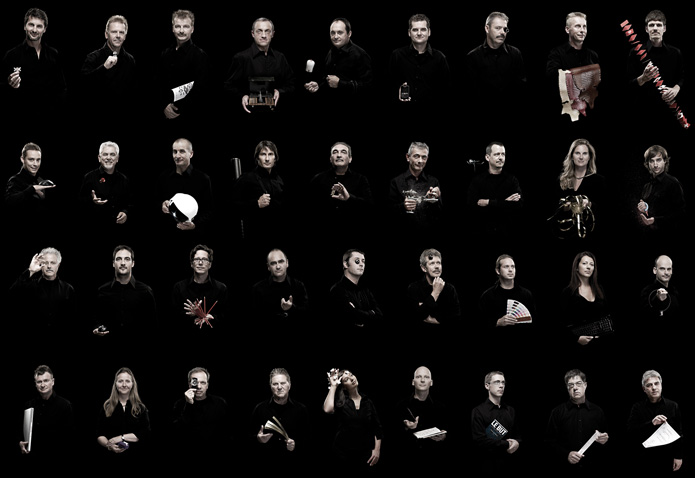
Horological Machine No2 Final Editions
Concept: Maximilian Büsser
Product Design: Eric Giroud / Eric Giroud Design Studio
Technical and Production Management: Serge Kriknoff/MB&F
Production logistics: David Lamy/MB&F
Movement Development: Jean-Marc Wiederrecht/Agenhor, Maximilien Di Blasi/Agenhor,
Patrick Lété/Artisans Horlogers
Movement fabrication: Salvatore Ferrarotto/APR Quality, Georges Auer/Mecawatch, Jose
Perez/Clamax, Gianni Di Blasi/Clamax
Hand-finishing of movement components: Jacques-Adrien Rochat/C-L Rochat, Denis
Garcia/C-L Rochat
Movement assemblage: Didier Dumas and Georges Veisy/MB&F
Case and buckle construction and production: Dominique Mainier, Bertrand Jeunet and
François Liard of G&F.Châtelain
Martin Stettler/Stettler Sapphire
Dials: François Bernhard and Denis Parel of Nateber
Hands: Pierre Chillier, Isabelle Chillier and Felix Celetta of Fiedler
Strap: Olivier Purnot/Camille Fournet
Presentation case: Isabelle Vaudaux/Vaudaux
Communication:
Graphic Design – Gérald Moulière and Alban Thomas of GVA Studio
Product Photography – Maarten van der Ende
Display Architecture – Frédéric Legendre/Lekoni
Portrait Photography – Régis Golay/Federal
Webmaster – Stéphane Balet and Guillaume Schmitz of Sumo Interactive
Texts – Ian Skellern
Project Manager – Estelle Tonelli/MB&F
Communication Assistant – Céline Cammalleri/MB&F
MB&F – The Genesis of a Concept Laboratory
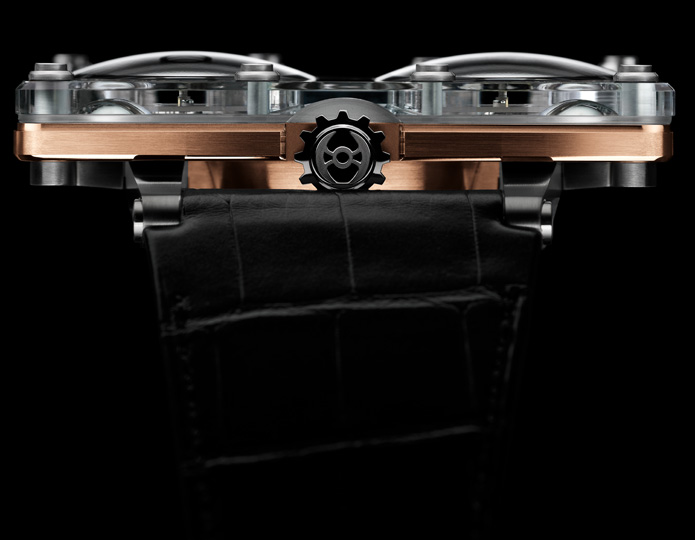
The projects that gave Maximilian Büsser the most pleasure and personal satisfaction during his seven year tenure as head of Harry Winston Timepieces, were those working with talented independent watchmakers on the exciting Opus series watches. An idea for his own personal utopia emerged; that of creating a company dedicated solely to designing and crafting small series of radical concept watches in collaboration with talented professionals he both respected and enjoyed working with. The entrepreneur in Büsser brought the idea to reality.
MB&F is not a watch brand, it is an artistic and micro-engineering concept laboratory in which collectives of independent horological professionals are assembled each year to design and craft radical Horological Machines. Respecting tradition without being shackled by it enables MB&F to act as a catalyst in fusing traditional high-quality watchmaking with cutting-edge technology and avant-garde three-dimensional sculpture.
MB&F is independent people creating for independent people.
Biography– Maximilian Büsser
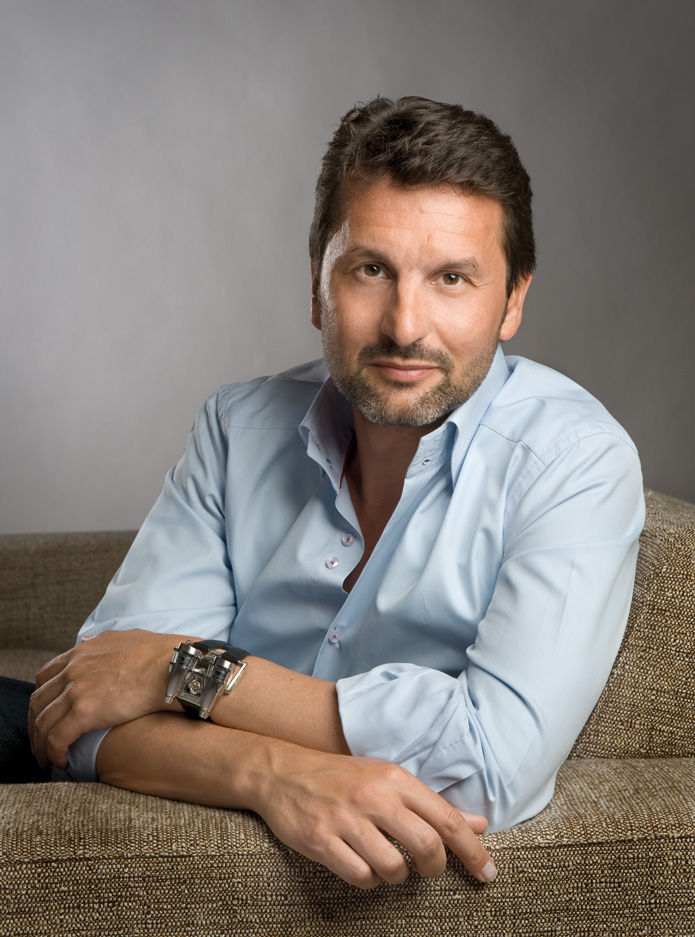
Maximilian Büsser was born in Milan, Italy, before moving at an early age to Lausanne, Switzerland where he spent his youth. Growing up in a multi-cultural environment and family – his father was a Swiss diplomat who met his mother, an Indian national, in Bombay – led Büsser to develop a cross-cultural broad-based approach to his life and to business.
In July 2005, at the age of 38, Maximilian created the world’s first horological Concept Brand: MB&F (Maximilian Büsser & Friends) in which he is now partnered with Serge Kriknoff. Büsser’s dream with MB&F is to have his own brand dedicated to developing radical horological concepts by working in small hyper-creative groups composed of people he enjoys working with. MB&F presented its first timepiece, Horological Machine No1 (HM1), in 2007 and followed that up with HM2 in 2008, HM3 in 2009 and HM4 Thunderbolt in 2010, with more radical machines in the development pipeline.
Entrepreneurship is Maximilian Büsser’s forte. In 1998 and only 31 years old, he was appointed managing director of Harry Winston Rare Timepieces in Geneva. During his seven years there Büsser developed the company into a fully-fledged and well respected haute horlogerie brand by developing the strategy, products, marketing and worldwide distribution, whilst integrating design, R&D and manufacturing in house. The results were a 900% increase in turnover and the positioning of Harry Winston as one of the leaders in this very competitive segment.
Prior to Harry Winston, Maximilian Büsser’s love for high-end horology was strongly imprinted by his first employer, Jaeger-LeCoultre. During his seven years in the senior management team during the 1990s, JLC strongly increased its profile and multiplied its turnover by a factor of ten. Büsser’s responsibilities at Jaeger-LeCoultre ranged from Product Management & Development to Sales & Marketing for Europe.
Maximilian graduated in 1991 with a Masters in Micro technology Engineering from the Swiss Federal Institute of Technology, Lausanne.

